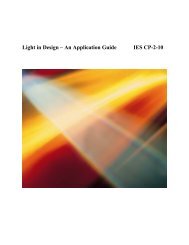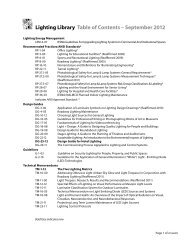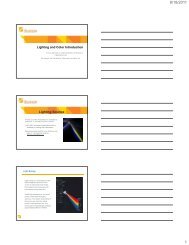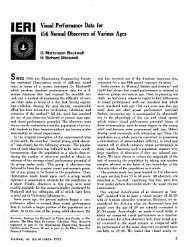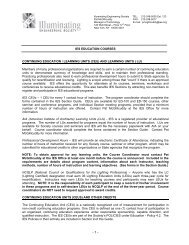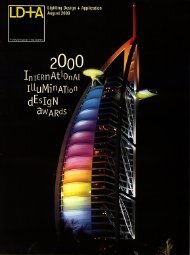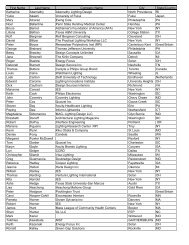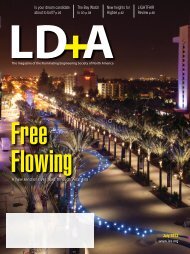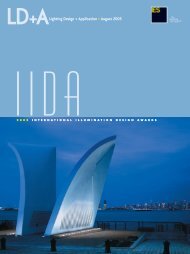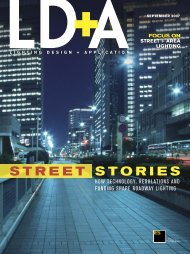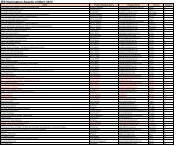light products - Illuminating Engineering Society
light products - Illuminating Engineering Society
light products - Illuminating Engineering Society
Create successful ePaper yourself
Turn your PDF publications into a flip-book with our unique Google optimized e-Paper software.
PHOTO: COURTESY OF ROBERT A. SHAKESPEARE<br />
Figure 4<br />
1985 Introduction of ISOPOINT<br />
(Lighting Analysts)<br />
Introduction of CALC-L (Lithonia)<br />
1986 Introduction of AutoLUX<br />
(Not ITL)<br />
1987 Introduction of INSIGHT<br />
(Lighting Analysts)<br />
Introduction of SPEC-L (Lithonia)<br />
1988 Introduction of AutoFLO<br />
(Not ITL)<br />
Introduction of LUX (OxyTech)<br />
1989 Introduction of Radiance<br />
(Lawrence Berkeley National<br />
Laboratory)<br />
lack of demand from end users to<br />
push software further than their current<br />
computational capabilities.<br />
Another area to pursue is more<br />
emphasis on day<strong>light</strong>ing. This includes<br />
better estimation of sky model conditions<br />
and the capability to do real-time<br />
animated studies illustrating the effects<br />
of day<strong>light</strong> over hours/days/months<br />
instead having to calculate individual<br />
points in time. Since the effect of day<strong>light</strong>ing<br />
on architecture is not static,<br />
our ability to see its influence throughout<br />
the year should reflect these varying<br />
conditions.<br />
As a frequent software user, I see<br />
the future of <strong>light</strong>ing design software<br />
heading in the same direction as<br />
recent CAD software developments.<br />
Over the past several years, high-end<br />
CAD software provide designers with<br />
“smart object” tools enabling us to<br />
incorporate more detailed information<br />
into our documentation. Using<br />
these tools, designers create intelligent<br />
3D models and let the computer<br />
build sections and elevations based on<br />
“slices” cut at specific points in the<br />
model. This eliminates some of the<br />
coordination discrepancies which<br />
occur when a drawing is modified but<br />
corresponding referenced drawings<br />
are not updated accordingly.<br />
Current .IES files contain photometric<br />
distribution and basic luminaire<br />
data such as dimensions, manufacturer,<br />
model number, etc., but they<br />
still do not include housing dimensions<br />
or other plenum information<br />
helpful when integrating into “smart<br />
models.” This additional information<br />
aids in indicating where there may be<br />
coordination problems with other<br />
plenum objects such as HVAC ducts,<br />
sprinkler lines or structural beams.<br />
Detecting these problem areas early<br />
in the design development or construction<br />
documentation phases prevents<br />
time and money lost when<br />
issues are revealed later in the field.<br />
Lastly, watch for the expansion of<br />
3D model offerings from <strong>light</strong>ing<br />
manufacturers. With the desire to<br />
create photo-realistic representations<br />
of designs, there is a greater<br />
need to go beyond simple utilization<br />
of <strong>light</strong>ing photometry in computer<br />
models. Designers want to show the<br />
client more than the effects of the<br />
<strong>light</strong> source but what the source itself<br />
looks like. Some <strong>light</strong>ing manufacturers<br />
offer 3D luminaire model libraries<br />
to integrate into 3D visualizations but<br />
the majority do not. Since manufacturers<br />
design new <strong>products</strong> on CAD,<br />
creating libraries of these 3D<br />
objects—integrated with IES photometry—would<br />
be very useful for<br />
<strong>light</strong>ing designers.<br />
Over the past four decades, <strong>light</strong>ing<br />
design software has developed at<br />
an exponential rate—each subsequent<br />
improvement or addition to<br />
software technology offering more<br />
efficient and effective production<br />
capabilities. Manufacturers quickly<br />
implement suggestions from user<br />
feedback and new versions come out<br />
as quickly as the need for new functions<br />
emerge—usually resulting from<br />
1991 Introduction of AGI DOS<br />
1992 Development of Lightscape<br />
(Lightscape Graphics Software)<br />
Introduction of GENESIS<br />
(Canlyte)<br />
Introduction of LITESTAR 1.00<br />
(OxyTech)<br />
1994 Introduction of Sulfur Lamp<br />
1996 Introduction of Lightscape SGI<br />
Version (Lightscape Technologies)<br />
1996 Introduction of Lightscape<br />
Windows NT version (Lightscape<br />
Technologies)<br />
Introduction of Visual 1.0<br />
(Lithonia)<br />
1999 Introduction of AGI32<br />
(Lighting Analysts)<br />
2001 Lightscape integrated into 3D<br />
Studio VIZ (Discreet)<br />
2002 Introduction of WinITL<br />
(Independent Testing<br />
Laboratories)<br />
2004 Introduction of Lumen Designer<br />
(Lighting Technologies)<br />
Dates are derived from sources including but not limited<br />
to A History of Light and Lighting Edition: 2.3 (2005) by<br />
Bill Williams; “Light’s Measure: A History of Industrial<br />
Photometry to 1909” by David DiLaura, published by<br />
IESNA (2005); CG 101: A Computer Graphics Industry<br />
Reference by Terrance Masson New Riders Publishing<br />
(1999);Radiosity:A Programmer’s Perspective by Ian Ashdown.<br />
December 2005 LD+A 61



